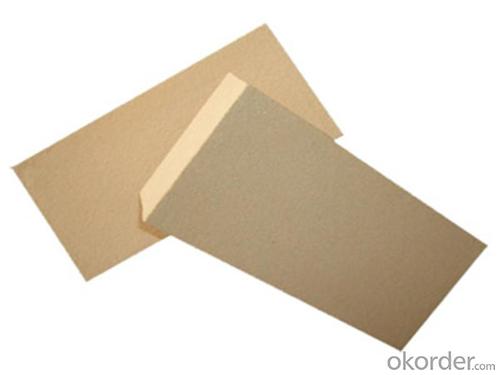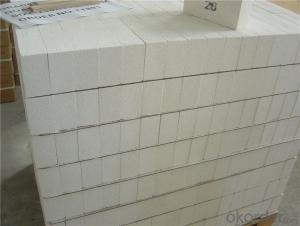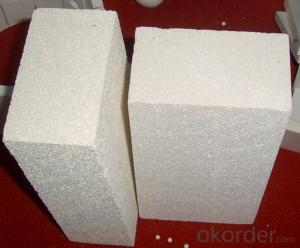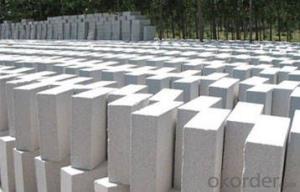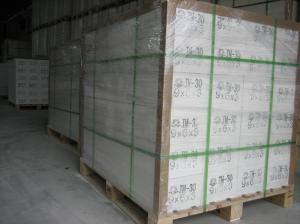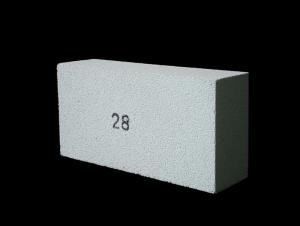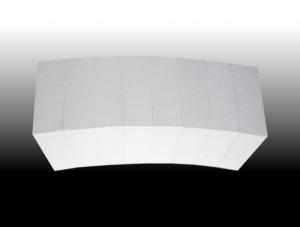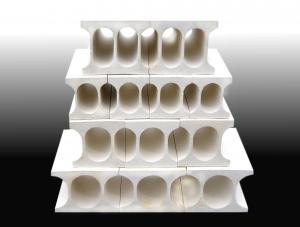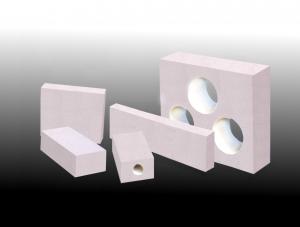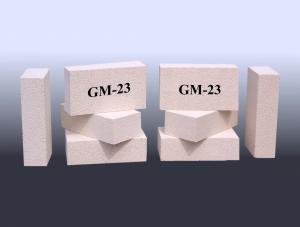Insulating Fire Brick - GJM Mullite Insulation Brick GJM-26
- Loading Port:
- Shanghai
- Payment Terms:
- TT OR LC
- Min Order Qty:
- 10 m.t.
- Supply Capability:
- 1000 m.t./month
OKorder Service Pledge
OKorder Financial Service
You Might Also Like
Specifications
mullite insulation brick
1. Low thermal conductivity
2.High hot compressive strength
3.Perfect Energy saving
Light weight mullite insulation furnace bricks refractory for sale
Advantage
1. Low thermal conductivity
2.High hot compressive strength
3.Perfect Energy saving
Description:
Lightweight mullite kiln bricks refractory for sale are made from good quality and superpure raw materials, with strictly classified fillings according to their grades. These fillings can form a uniform pore structure after burnt during the process of manufacture. Each grade of products has unique design to meet different thermal, physical and chomical demands.
Application:
Mullite insulation furnace bricks refractory material can be used in linings or heat-insulating materials of the industries, such as, ethylene pyrolysis furnaces, tubular furnaces, reforming furnaces of synthetic ammonia, gas generators and high-temperature shullte kilns, etc
Mullite Insulation furnace refractory material can be used as working lining, where contact with flames directly. This kind of brick can save the kiln energy very much
- Q: How do insulating fire bricks provide thermal insulation?
- Insulating fire bricks provide thermal insulation due to their low thermal conductivity and high porosity. The bricks are made from lightweight materials such as clay, alumina, or silica, which have low thermal conductivity. The high porosity of these bricks allows for the trapping of air or gas bubbles within their structure, which further reduces heat transfer. As a result, insulating fire bricks effectively minimize the conduction of heat, making them ideal for applications that require thermal insulation.
- Q: What is the difference between insulating fire bricks and regular fire bricks?
- Insulating fire bricks are designed to have lower thermal conductivity, allowing them to retain heat more effectively and prevent heat loss. Regular fire bricks, on the other hand, have higher thermal conductivity as they are primarily used for structural purposes and to withstand high temperatures.
- Q: Can insulating fire bricks be used in chimneys?
- Yes, insulating fire bricks can be used in chimneys. Insulating fire bricks are designed to withstand high temperatures, making them an ideal choice for lining chimneys. They have excellent thermal insulation properties, which help to prevent heat loss and increase the efficiency of the chimney. Additionally, insulating fire bricks are lightweight and easy to install, making them a convenient option for chimney lining. However, it is important to note that insulating fire bricks are not suitable for all types of chimneys. It is recommended to consult a professional or chimney specialist to determine the appropriate materials for your specific chimney needs.
- Q: How do insulating fire bricks compare to ceramic fiber insulation?
- Insulating fire bricks, also referred to as refractory bricks, consist of refractory clay and other materials, giving them their dense and heavy composition. These bricks possess exceptional thermal conductivity and insulation properties. Renowned for their durability and ability to withstand high temperatures, insulating fire bricks find applications in furnaces, kilns, and various industrial settings. On the contrary, ceramic fiber insulation comprises a lightweight material composed of alumina-silica fibers. This type of insulation offers high flexibility, enabling easy shaping and molding to suit diverse applications. Ceramic fiber insulation is recognized for its superb thermal insulation properties and low thermal conductivity. Furthermore, it exhibits resistance to thermal shock and can endure rapid temperature fluctuations. Regarding insulation performance, both insulating fire bricks and ceramic fiber insulation entail their respective advantages. Insulating fire bricks exhibit elevated thermal conductivity, facilitating efficient heat transfer. Consequently, they are ideal for applications necessitating rapid and uniform heat distribution. Conversely, ceramic fiber insulation displays lower thermal conductivity, thereby excelling in preventing heat transfer. Regarding installation and maintenance, ceramic fiber insulation proves more manageable owing to its lightweight and flexible nature. It can be effortlessly cut and shaped to fit intricate surfaces, minimizing the requirement for specialized tools or equipment. In contrast, insulating fire bricks, being heavier and more rigid, demand greater effort and precision during installation. Ultimately, the choice between insulating fire bricks and ceramic fiber insulation depends on the specific demands of the application. Insulating fire bricks suit applications requiring heightened thermal conductivity and durability, while ceramic fiber insulation proves ideal for applications demanding exceptional thermal insulation and flexibility.
- Q: Can insulating fire bricks be used for insulation in flues?
- Insulating fire bricks are created with the specific purpose of being used in high-temperature settings, such as furnaces, kilns, and various industrial environments. Their main function is to effectively insulate heat and prevent heat loss. However, it is important to note that they are not suitable for use in flues. Flues are exposed to extreme temperatures, corrosive gases, and the possibility of accumulation of soot and creosote. The conditions in flues are not compatible with insulating fire bricks, as they are not designed to withstand such harsh elements. Consequently, when exposed to the acidic and corrosive gases generated by combustion, these bricks may deteriorate or develop cracks over time. To ensure proper insulation in flues, it is advisable to opt for materials that are specifically manufactured for this purpose, such as refractory cement or ceramic fiber insulation. These materials are better equipped to withstand the challenging conditions encountered in flues and are more capable of providing effective insulation while maintaining the safety and durability of the flue system.
- Q: Can insulating fire bricks be used in the construction of incineration kilns?
- Yes, insulating fire bricks can be used in the construction of incineration kilns. These bricks have excellent thermal insulation properties, which helps in maintaining high temperatures inside the kiln while minimizing heat loss to the surroundings. This is crucial in incineration processes where high temperatures are required to efficiently burn waste materials. Additionally, insulating fire bricks are resistant to thermal shock and can withstand the extreme temperatures and harsh conditions typically found in incineration kilns.
- Q: Do insulating fire bricks have any impact on indoor air quality?
- Insulating fire bricks, also known as refractory bricks, are primarily used in high-temperature applications such as fireplaces, kilns, and furnaces. These bricks are designed to withstand extreme heat and provide insulation, preventing the transfer of heat to surrounding areas. In terms of indoor air quality, insulating fire bricks do not have a direct impact. Since insulating fire bricks are made from materials such as clay, alumina, and silica, they are generally inert and do not release any harmful substances into the air when exposed to normal temperatures. However, it is important to note that during the manufacturing process, certain chemicals or additives may be used, which could potentially have an impact on air quality if not properly regulated or controlled. Additionally, the installation and maintenance of insulating fire bricks can indirectly affect indoor air quality. For example, if the bricks are not installed correctly or become damaged over time, they may develop cracks or gaps that could allow the escape of harmful gases or particulate matter. In such cases, it is crucial to promptly repair or replace damaged bricks to ensure the integrity of the insulation and prevent any negative impact on indoor air quality. Furthermore, the use of insulating fire bricks in fireplaces or wood-burning stoves can indirectly influence indoor air quality. When these devices are operated, they can release smoke, particulate matter, and potentially harmful gases into the air. It is essential to ensure proper ventilation and use high-quality flue systems to minimize the impact on indoor air quality when using such appliances. In summary, insulating fire bricks themselves do not have a direct impact on indoor air quality. However, it is important to consider factors such as the manufacturing process, installation, and maintenance to ensure that these bricks do not contribute to any degradation of the air we breathe.
- Q: What is the density of insulating fire bricks?
- The density of insulating fire bricks typically ranges from 0.6 to 1.5 grams per cubic centimeter (g/cm³). However, the exact density can vary depending on the specific composition and manufacturing process of the insulating fire brick. These bricks are designed to have lower density compared to regular fire bricks, which allows them to have better insulating properties. The lower density helps in reducing heat transfer and increasing energy efficiency in various applications such as furnaces, kilns, and ovens.
- Q: What is the exterior wall insulation material made of graphite?
- Graphite polystyrene (SEPS) containing graphite particles special, can be like a mirror which contains thermal radiation, and can greatly enhance the heat insulation performance of the infrared absorption, thereby reducing the heat loss of housing. Its insulation capacity is at least 30% higher than the average EPS, helping to increase energy efficiency and reduce carbon dioxide emissions.
- Q: Are insulating fire bricks resistant to thermal radiation?
- Yes, insulating fire bricks are designed to be resistant to thermal radiation. These bricks are made from materials that have low thermal conductivity and high thermal resistance, allowing them to effectively insulate against heat transfer through radiation.
Send your message to us
Insulating Fire Brick - GJM Mullite Insulation Brick GJM-26
- Loading Port:
- Shanghai
- Payment Terms:
- TT OR LC
- Min Order Qty:
- 10 m.t.
- Supply Capability:
- 1000 m.t./month
OKorder Service Pledge
OKorder Financial Service
Similar products
Hot products
Hot Searches
Related keywords

